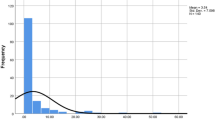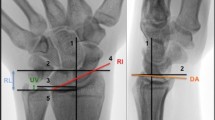Abstract
The purpose of this study was to evaluate the relationship between radiological and functional results in patients with extra-articular fractures of the distal radius. We conducted a prospective study of radiological and functional assessment in 95 consecutively selected extra-articular distal radius fractures. There were two patient groups: more than 60 and less than 60 years of age. The final fracture union radiographs were analysed for their functional outcome using the Michigan Hand Outcomes Questionnaire (MHQ) and the Disabilities of the Arm, Shoulder and Hand (DASH) questionnaire. In patients with acceptable radiological results, 62% (MHQ group) and 72% (DASH group) of patients had satisfactory functional outcome. Analysing patients with satisfactory functional results, 56% (MHQ group) and 59% (DASH group) had satisfactory radiological results. There was a higher proportion of patients with better functional results, despite poor radiological results, in both of the age groups. There was a statistically significant correlation between satisfactory radial tilt and functional outcome in the younger patients. In the older age group, patients with satisfactory radiological results had satisfactory functional outcome (p < 0.05). However, in the older age group, satisfactory functional results were achieved, despite unsatisfactory radiological results.
Résumé
Le propos de cette étude est d’évaluer les relations entre les résultats radiologiques et fonctionnels des patients ayant présenté une fracture extra articulaire de l’extrémité distale du radius. Une étude prospective et radiologique a été menée chez 95 patients consécutifs présentant ce type de fractures. Ils ont été divisés en deux groupes, le groupe de plus de 60 ans et le groupe de moins de 60 ans. La consolidation finale, radiographique, a été analysée de même que le résultat fonctionnel en utilisant le score de Michigan et le questionnaire DASH. Si l’on prend les patients présentant un résultat radiologique acceptable, 62% selon le score Michigan et 72% selon le score DASH, ceux-ci ont un résultat fonctionnel satisfaisant. Si l’on analyse les patients à partir du score fonctionnel : 56% ayant un score Michigan satisfaisant et 59% un score DASH satisfaisant ceux-ci ont une consolidation radiologique également satisfaisante. Les résultats montrent qu’il existe une proportion élevée de patients ayant un score fonctionnel satisfaisant en dépit d’un résultat radiologique peu satisfaisant dans chaque groupe d’âge. De même il existe une relation statistiquement significative entre la bascule de l’extrémité distale du radius et le résultat fonctionnel chez les patients jeunes. Dans le groupe des patients âgés de plus de 60 ans ceux qui ont un résultat radiologique satisfaisant ont également un résultat cliniquement satisfaisant (p < 0.05). Cependant dans le groupe des patients les plus âgés les résultats fonctionnels satisfaisants sont observés malgré des résultats radiologiques peu satisfaisants.





Similar content being viewed by others
References
Broos PL, Fourneau IA, Stoffelen DV (2001) Fractures of the distal radius. Current concepts for treatment. Acta Orthop Belg 67(3):211–218
Cassebaum WH (1950) Colles’ fracture. A study of end results. J Am Med Assoc 143(11):963–965
Chung KC, Hamill JB, Walters MR, Hayward RA (1999) The Michigan Hand Outcomes Questionnaire (MHQ): assessment of responsiveness to clinical change. Ann Plast Surg 42(6):619–622
Cooney WP 3rd, Dobyns JH, Linscheid RL (1980) Complications of Colles’ fractures. J Bone J Surg Am 62(4):613–619
Dias JJ, Wray CC, Jones JM (1987) The radiological deformity of Colles’ fractures. Injury 18(5):304–308
Fernandez DL, Martin CJ (2001) Classification and conservative treatment of distal radius fractures. In: Watson HK, Weinzweig J (eds) The wrist. Lippincott Williams & Wilkins, Philadelphia, Pennsylvania, pp 277–298
Frykman G (1967) Fracture of the distal radius including sequelae–shoulder-hand-finger syndrome, disturbance in the distal radio-ulnar joint and impairment of nerve function. A clinical and experimental study. Acta Orthop Scand 108(Suppl):1–155
Graham TJ (1997) Surgical correction of malunited fractures of the distal radius. J Am Acad Orthop Surg 5(5):270–281
Hove LM, Fjeldsgaard K, Skjeie R, Solheim E (1995) Anatomical and functional results five years after remanipulated Colles’ fractures. Scand J Plast Reconstr Surg Hand Surg 29(4):349–355
Kaukonen JP, Porras M, Karaharju E (1988) Anatomical results after distal forearm fractures. Ann Chir Gynaecol 77(1):21–26
McQueen M, Caspers J (1988) Colles’ fracture: does the anatomical result affect the final function? J Bone Joint Surg Br 70(4):649–651
McQueen MM, MacLaren A, Chalmers J (1986) The value of remanipulating Colles’ fractures. J Bone Joint Surg Br 68(2):232–233
Platt H (1932) Colles’ fracture. Br Med J 2:288–292
Porter ML, Stockley I (1984) Functional index: a numerical expression of post-traumatic wrist function. Injury 16(3):188–192
Rosenthal AH, Chung KC (2002) Intrafocal pinning of distal radius fractures: a simplified approach. Ann Plast Surg 48(6):593–599
Smaill BG (1965) Long-term follow-up of Colles’s fracture. J Bone Joint Surg Br 47(1):80–85
Smilovic J, Bilic R (2003) Conservative treatment of extra-articular Colles’ type fractures of the distal radius: prospective study. Croatian Med J 44(6):740–745
Stein H, Volpin G, Horesh Z, Hoerer D (1990) Cast or external fixation for fracture of the distal radius. A prospective study of 126 cases. Acta Orthop Scand 61(5):453–456
Steward HD, Innes AR, Burke FD (1985) Factors affecting the outcome of Colles’ fracture: an anatomical and functional study. Injury 16(5):289–295
Villar RN, Marsh D, Rushton N, Greatorex RA (1987) Three years after Colles’ fracture. A prospective review. J Bone J Surg Br 69(4):635–638
Wakefield AE, McQueen MM (2000) The role of physiotherapy and clinical predictors of outcome after fracture of the distal radius. J Bone Joint Surg Br 82(7):972–976
Westphal T, Piatek S, Schubert S, Schuschke T, Winckler S (2002) Reliability and validity of the upper limb DASH questionnaire in patients with distal radius fractures (in German). Z Orthop Ihre Grenzgeb 140(4):447–451
Young CF, Nanu AM, Checketts RG (2003) Seven-year outcome following Colles’ type distal radial fracture. A comparison of two treatment methods. J Hand Surg Br 28(5):422–426
Young BT, Rayan GM (2000) Outcome following nonoperative treatment of displaced distal radius fractures in low-demand patients older than 60 years. J Hand Surg Am 25(1):19–28
Author information
Authors and Affiliations
Corresponding author
Rights and permissions
About this article
Cite this article
Kumar, S., Penematsa, S., Sadri, M. et al. Can radiological results be surrogate markers of functional outcome in distal radial extra-articular fractures?. International Orthopaedics (SICO 32, 505–509 (2008). https://doi.org/10.1007/s00264-007-0355-4
Received:
Revised:
Accepted:
Published:
Issue Date:
DOI: https://doi.org/10.1007/s00264-007-0355-4




